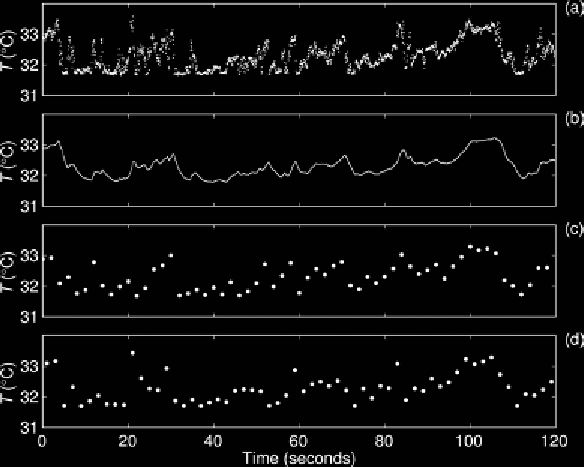Geoscience Reference
In-Depth Information
Figure 3.10
Illustration of the requirements for sensor response and number of samples,
for vertical wind speed (left) and temperature (right). (
a
) fast sensor, sampled at 20 Hz
(
σ
T
= 0.459 K). (
b
) slow sensor, sampled at 20 Hz (
σ
T
= 0.355 K). (
c
) fast sensor, sam-
pled at 0.5 Hz (
σ
T
= 0.452 K). (
d
) fast sensor, sampled at 0.5 Hz, different starting time
(
σ
T
= 0.470 K). The data are a subset of the data shown in
Figure 3.4
(minutes 12 and 13).
where RE denote the relative error and
σ
w
and
σ
x
are the standard deviations of the
vertical wind speed and the transported quantity, respectively, and
R
wx
is the correlation
coeficient between
w
and
x
As the correlation between vertical wind speed and, for
example, temperature or humidity is not very large in the surface layer (between 0.25
and 0.55), the error in luxes is larger than the error in the standard deviations. To mini-
mize the error, the error in the estimates of
σ
w
and
σ
x
need to be minimized. In general
this implies that one tries to maximize the number of samples, which can be done by
increasing the sampling rate and by extending the period over which one averages.
The issue of the sampling frequency is illustrated in
Figures 3.10c
and
d
. At low
sampling frequencies only a small number of samples are gathered and the quanti-
ties computed from this limited amount of data will have a relatively large statistical
(random) error: the time series of
Figure 3.10c
overestimates the standard deviation,
whereas in part d it is underestimated. On the other hand, the signals in both parts c and
d capture the essence of the original signal shown in part d. Increasing the sampling
frequency beyond a certain point does not help to minimize the error as the samples
become mutually dependent
10
(the extra samples contain little new information).
10
Sampling rates that are so high that samples are mutually dependent
can
be useful in case one is interested in the
temporal or spectral behaviour of the turbulence, rather than luxes and variances.

Search WWH ::

Custom Search